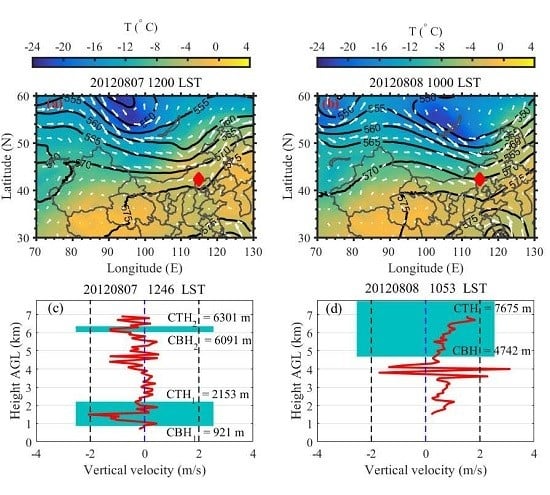A Novel Method for Estimating the Vertical Velocity of Air with a Descending Radiosonde System
Abstract
1. Introduction
2. The Concept of the Descending Radiosonde System
3. Site, Data and Methodology
3.1. Site
3.2. Data
3.3. Methodology
3.3.1. VV Estimation Algorithm
3.3.2. Radiosonde-Based Cloud Layer Identification
4. Uncertainty Analysis and Credibility Assessment of VV Retrievals
4.1. Uncertainty Estimation
4.2. Composite Analysis
4.3. Case Study
5. Discussion and Conclusions
Author Contributions
Funding
Acknowledgments
Conflicts of Interest
References
- Heymsfield, A.J. Precipitation Development in Stratiform Ice Clouds: A Microphysical and Dynamical Study. J. Atmos. Sci. 1977, 34, 367–381. [Google Scholar] [CrossRef]
- Li, Z.; Lau, W.K.M.; Ramanathan, V.; Wu, G.; Ding, Y.; Manoj, M.G.; Liu, J.; Zhou, T.; Fan, J.; Rosenfeld, D.; et al. Aerosol and monsoon climate interactions over Asia. Rev. Geophys. 2016, 54, 866–929. [Google Scholar] [CrossRef]
- Zhao, B.; Jiang, J.H.; Diner, D.J.; Su, H.; Gu, Y.; Liou, K.N.; Jiang, Z.; Huang, L.; Takano, Y.; Fan, X.; et al. Intra-annual variations of regional aerosol optical depth, vertical distribution, and particle types from multiple satellite and ground-based observational datasets. Atmos. Chem. Phys. 2018, 18, 11247–11260. [Google Scholar] [CrossRef] [PubMed]
- Paluch, I.R.; Lenschow, D.H. Stratiformcloud formation in the marine boundary layer. J. Atmos. Sci. 1991, 48, 2141–2158. [Google Scholar] [CrossRef]
- Sun, J.; Leighton, H.; Yau, M.K.; Ariya, P. Numerical evidence for cloud droplet nucleation at the cloud-environment interface. Atmos. Chem. Phys. 2012, 12, 12155–12164. [Google Scholar] [CrossRef]
- Leary, C.A.; Houze, R.A. The contribution of mesoscale motions to the mass and heat fluxes of an intense tropical convective system. J. Atmos. Sci. 1980, 37, 784–796. [Google Scholar] [CrossRef]
- Stern, D.P.; Aberson, S.D. Extreme vertical winds measured by dropwindsondes in hurricanes. In Proceedings of the 27th Conference on Hurricanes and Tropical Meteorology, Monterey, CA, USA, 28 April 2006; Available online: http://ams.confex.com/ams/pdfpapers/108766.pdf (accessed on 8 May 2019).
- Kim, Y.J.; Eckermann, S.D.; Chun, H.Y. An overview of the past, present and future of gravity-wave drag parameterization for numerical climate and weather prediction models. Atmos. Ocean 2003, 41, 65–98. [Google Scholar]
- Holton, J.R. An Introduction to Dynamic Meteorology; Academic Press: San Diego, CA, USA, 1922; p. 507. [Google Scholar]
- Lenschow, D.H.; Stephens, P.L. The role of thermals in the convective boundary layer. Bound. Layer Meteor. 1980, 19, 509–532. [Google Scholar] [CrossRef]
- Greenhut, G.K.; Singh Khalsa, S.J. Updraft and downdraft events in the atmospheric boundary layer over the equatorial Pacific Ocean. J. Atmos. Sci. 1982, 39, 1803–1818. [Google Scholar] [CrossRef]
- Saïd, F.; Canut, G.; Durand, P.; Lohou, F.; Lothon, M. Seasonal evolution of boundary-layer turbulence measured by aircraft during the AMMA 2006 Special Observation Period. Quart. J. R. Meteor. Soc. 2010, 136, 47–65. [Google Scholar] [CrossRef]
- Balsley, B.B.; Ecklund, W.L.; Carter, D.A.; Riddle, A.C.; Gage, K.S. Average vertical motions in the tropical atmosphere observed by a radar wind profiler on Pohnpei (7oN latitude, 157oE longitude). J. Atmos. Sci. 1988, 45, 396–405. [Google Scholar] [CrossRef]
- Shupe, M.D.; Kollias, P.; Poellot, M.; Eloranta, E. On deriving vertical air motions from cloud radar Doppler spectra. J. Atmos. Ocean. Technol. 2008, 25, 547–557. [Google Scholar] [CrossRef]
- Kollias, P.; Albrecht, B.A.; Lhermitte, R.; Savtchenko, A. Radar observations of updrafts, downdrafts, and turbulence in fair-weather cumuli. J. Atmos. Sci. 2001, 58, 1750–1766. [Google Scholar] [CrossRef]
- Ansmann, A.; Fruntke, J.; Engelmann, R. Updraft and downdraft characterization with Doppler lidar: Cloud-free versus cumuli-topped mixed layer. Atmos. Chem. Phys. 2010, 10, 7845–7858. [Google Scholar] [CrossRef]
- Contini, D.; Mastrantonio, G.; Viola, A.; Argentini, S. Mean vertical motions in the PBL measured by Doppler sodar: Accuracy, ambiguities, and possible improvements. J. Atmos. Oceanic Technol. 2004, 21, 1532–1544. [Google Scholar] [CrossRef]
- Zhao, K.; Wang, M.; Xue, M.; Fu, P.; Yang, Z.; Chen, X.; Zhang, Y.; Lee, W.; Zhang, F.; Lin, Q.; et al. Doppler radar analysis of a tornadic miniature supercell during the Landfall of Typhoon Mujigae (2015) in South China. Bull. Amer. Meteor. Soc. 2017, 98, 1821–1831. [Google Scholar] [CrossRef]
- Zheng, Y.; Rosenfeld, D. Linear relation between convective cloud base height and updrafts and application to satellite retrievals. Geophys. Res. Lett. 2015, 42, 6485–6491. [Google Scholar] [CrossRef]
- Zheng, Y.; Rosenfeld, D.; Li, Z. Satellite inference of thermals and cloud base updraft speeds based on retrieved surface and cloud base temperatures. J. Atmos. Sci. 2015, 72, 2411–2428. [Google Scholar] [CrossRef]
- Zheng, Y.; Rosenfeld, D.; Li, Z. Quantifying cloud base updraft speeds of marine stratocumulus from cloud top radiative cooling. Geophys. Res. Lett. 2016, 43, 11407–11413. [Google Scholar] [CrossRef]
- Luo, Z.J.; Jeyaratnam, J.; Iwasaki, S.; Takahashi, H.; Anderson, R. Convective vertical velocity and cloud internal vertical structure: An A-Train perspective. Geophys. Res. Lett. 2014, 41, 723–729. [Google Scholar] [CrossRef]
- Treddenick, D.S. A comparison of aircraft and Jimsphere wind measurements. J. Appl. Meteor. 1971, 10, 309–312. [Google Scholar] [CrossRef]
- Franklin, J.; Black, M.L.; Valde, K. GPS dropwindsonde wind profiles in hurricanes and their operational implications. Weather Forecast. 2003, 18, 32–44. [Google Scholar] [CrossRef]
- Gallice, A.; Wienhold, F.G.; Hoyle, C.R.; Immler, F.; Peter, T. Modeling the ascent of sounding balloons: Derivation of the vertical air motion. Atmos. Meas. Tech. 2011, 4, 2235–2253. [Google Scholar] [CrossRef]
- Bony, S.; Stevens, B. Measuring area-averaged vertical motions with dropsondes. J. Atmos. Sci. 2019, 76, 767–783. [Google Scholar] [CrossRef]
- Lalas, D.P.; Einaudi, F. Tropospheric gravity waves: Their diction by and influence on rawinsonde balloon data. Quart. J. R. Meteor. Soc. 1980, 106, 855–864. [Google Scholar] [CrossRef]
- McHugh, J.P.; Dors, I.; Jumper, G.Y.; Roadcap, J.R.; Murphy, E.A.; Hahn, D.C. Large variations in balloon ascent rate over Hawaii. J. Geophys. Res. 2008, 113, D15123. [Google Scholar] [CrossRef]
- Johansson, C.; Bergström, H. An auxiliary tool to determine the height of the boundary layer. Bound. Layer Meteor. 2005, 115, 423–432. [Google Scholar] [CrossRef]
- Wang, J.; Bian, J.; Brown, W.O.; Cole, H.; Grubišić, V.; Young, K. Vertical Air Motion from T-REX Radiosonde and Dropsonde Data. J. Atmos. Ocean. Technol. 2009, 26, 928–942. [Google Scholar] [CrossRef]
- Wick, G.A.; Hock, T.F.; Neiman, P.J.; Vomel, H.; Black, M.L.; Spackman, J.R. The NCAR–NOAA Global Hawk Dropsonde System. J. Atmos. Ocean. Technol. 2018, 35, 1585–1604. [Google Scholar] [CrossRef]
- Wu, C.C.; Chou, K.H.; Lin, P.H.; Aberson, S.D.; Peng, M.S.; Nakazawa, T. The impact of dropwindsonde data on typhoon track forecasts in DOTSTAR. Weather Forecast. 2007, 22, 1157–1176. [Google Scholar] [CrossRef]
- MacCready, P.B. Comparison of some balloon techniques. J. Appl. Meteor. 1965, 4, 504–508. [Google Scholar] [CrossRef]
- Nash, J.; Oakley, T.; Vömel, H.; Li, W. WMO Intercomparison of High Quality Radiosonde Systems, Yangjiang, China, 12 July–3 August 2010. Tech. Rep., WMO, 2011, WMO/TD-No. 1580, Instruments and Observing Methods Report No. 107. Available online: http://library.wmo.int/pmb_ged/wmo-td_1580.pdf (accessed on 10 December 2018).
- Xie, Q.; Huang, K.; Wang, D.; Yang, L.; Chen, J.; Wu, Z.; Li, D.; Liang, Z. Intercomparison of GPS radiosonde soundings during the eastern tropical Indian Ocean experiment. Acta Oceanol. Sin. 2014, 33, 127–134. [Google Scholar] [CrossRef]
- Hou, T.; Lei, H.; Yang, J.; Hu, Z.; Feng, Q. Investigation of riming within mixed-phase stratiform clouds using Weather Research and Forecasting (WRF) model. Atmos. Res. 2016, 178–179, 291–303. [Google Scholar] [CrossRef]
- Zhang, J.; Li, Z.; Chen, H.; Cribb, M. Validation of a radiosonde-based cloud layer detection method against a ground-based remote sensing method at multiple ARM sites. J. Geophys. Res. 2013, 118, 846–858. [Google Scholar] [CrossRef]
- Miloshevich, L.M.; Vömel, H.; Whiteman, D.N.; Lesht, B.M.; Schmidlin, F.J.; Russo, F. Absolute accuracy of water vapor measurements from six operational radiosonde types launched during AWEX-G and implications for AIRS validation. J. Geophys. Res. 2006, 111, D09S10. [Google Scholar] [CrossRef]
- Zhang, J.; Chen, H.; Bian, J.; Xuan, Y.; Duan, Y.; Cribb, M. Development of cloud detection methods using CFH, GTS1, and RS80 radiosondes. Adv. Atmos. Sci. 2012, 29, 236–248. [Google Scholar] [CrossRef]
- Bian, J.; Chen, H.; Vömel, H.; Duan, Y.; Xuan, Y.; Lü, D. Intercomparison of humidity and temperature sensors: GTS1, Vaisala RS80, and CFH. Adv. Atmos. Sci. 2011, 28, 139–146. [Google Scholar] [CrossRef]
- Guo, Q.Y.; Li, F.; Guo, K.; Yang, R.K. Comparative analysis of new GPS and GTS1-2 radiosondes. Meteor. Sci. Technol. 2005, 43, 59–64, (In Chinese with English Abstract). [Google Scholar]
- Vennard, J.K. Elementary Fluid Mechanics, 7th ed.; John Wiley & Sons: Hoboken, NJ, USA, 1955; p. 401. [Google Scholar]
- Shi, H.; Chen, H.; Xia, X.; Fan, X.; Zhang, J.; Li, J.; Ling, C. Intensive radiosonde measurements of summertime convection over the Inner Mongolia grassland in 2014: Difference between shallow cumulus and other conditions. Adv. Atmos. Sci. 2017, 34, 783–790. [Google Scholar] [CrossRef]
- Zhuang, Y.; Fu, R.; Marengo, J.A.; Wang, H. Seasonal variation of shallow-to-deep convection transition and its link to the environmental conditions over the Central Amazon. J. Geophys. Res. 2017, 122, 2649–2666. [Google Scholar] [CrossRef]
- Yang, J.; Wang, Z.; Heymsfield, A.J.; French, J.R. Characteristics of vertical air motion in isolated convective clouds. Atmos. Chem. Phys. 2016, 16, 10159–10173. [Google Scholar] [CrossRef]
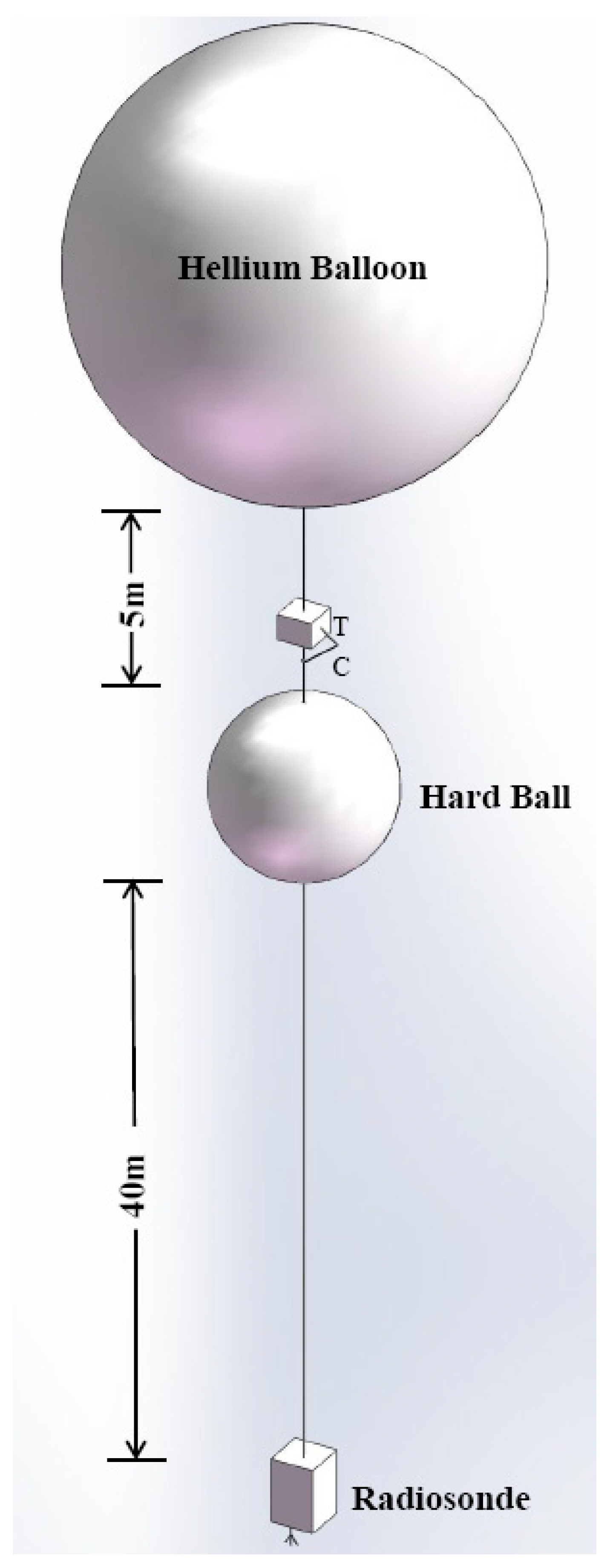
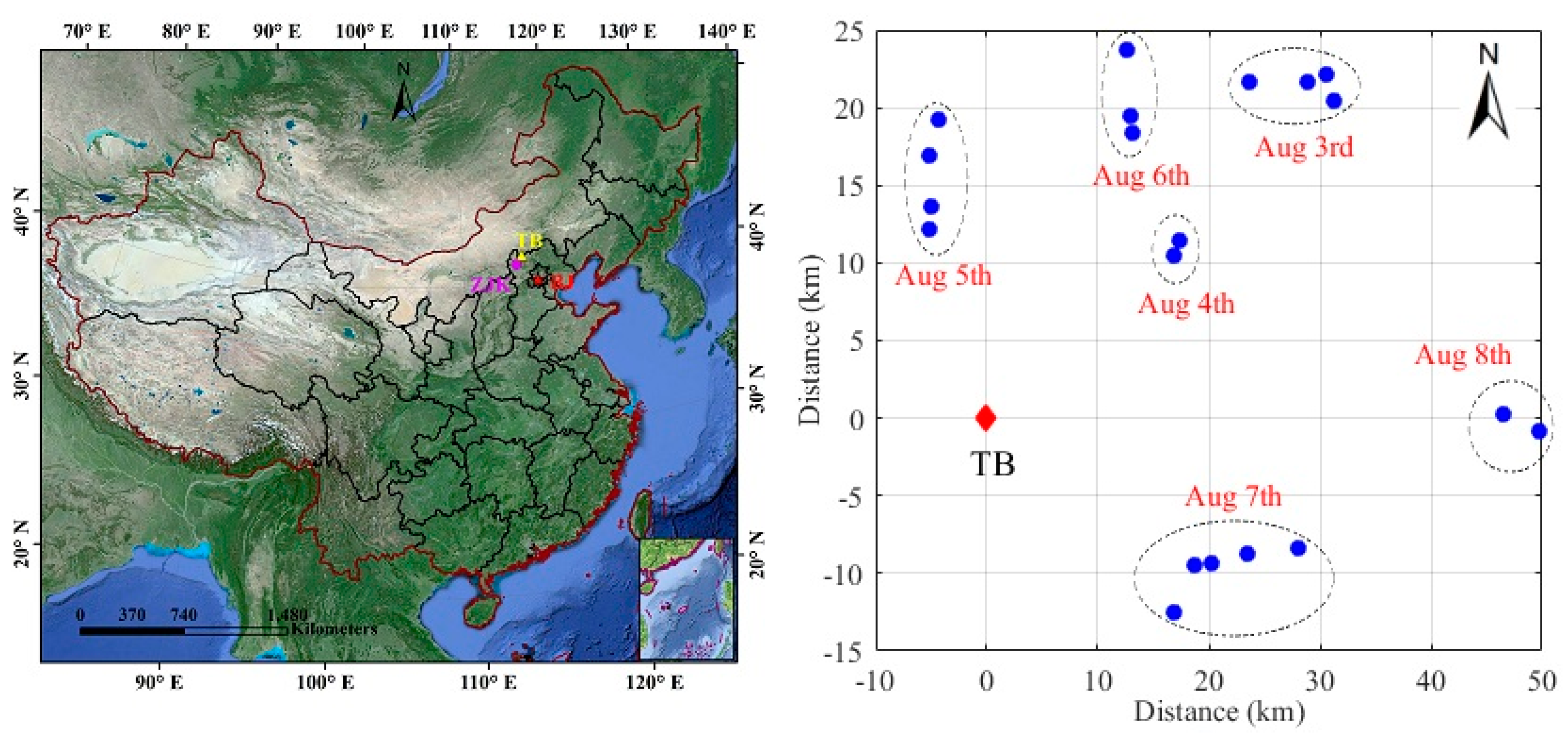
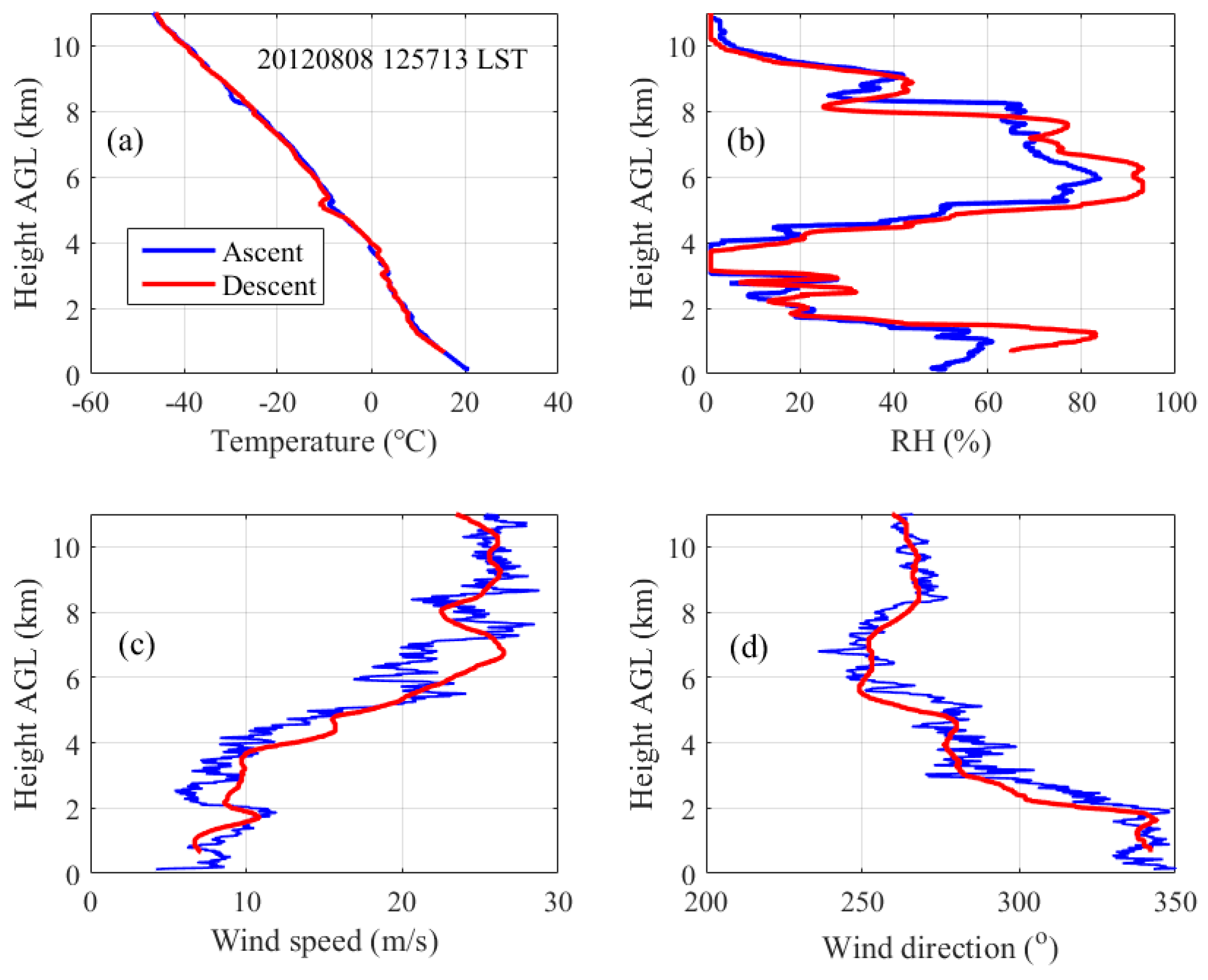
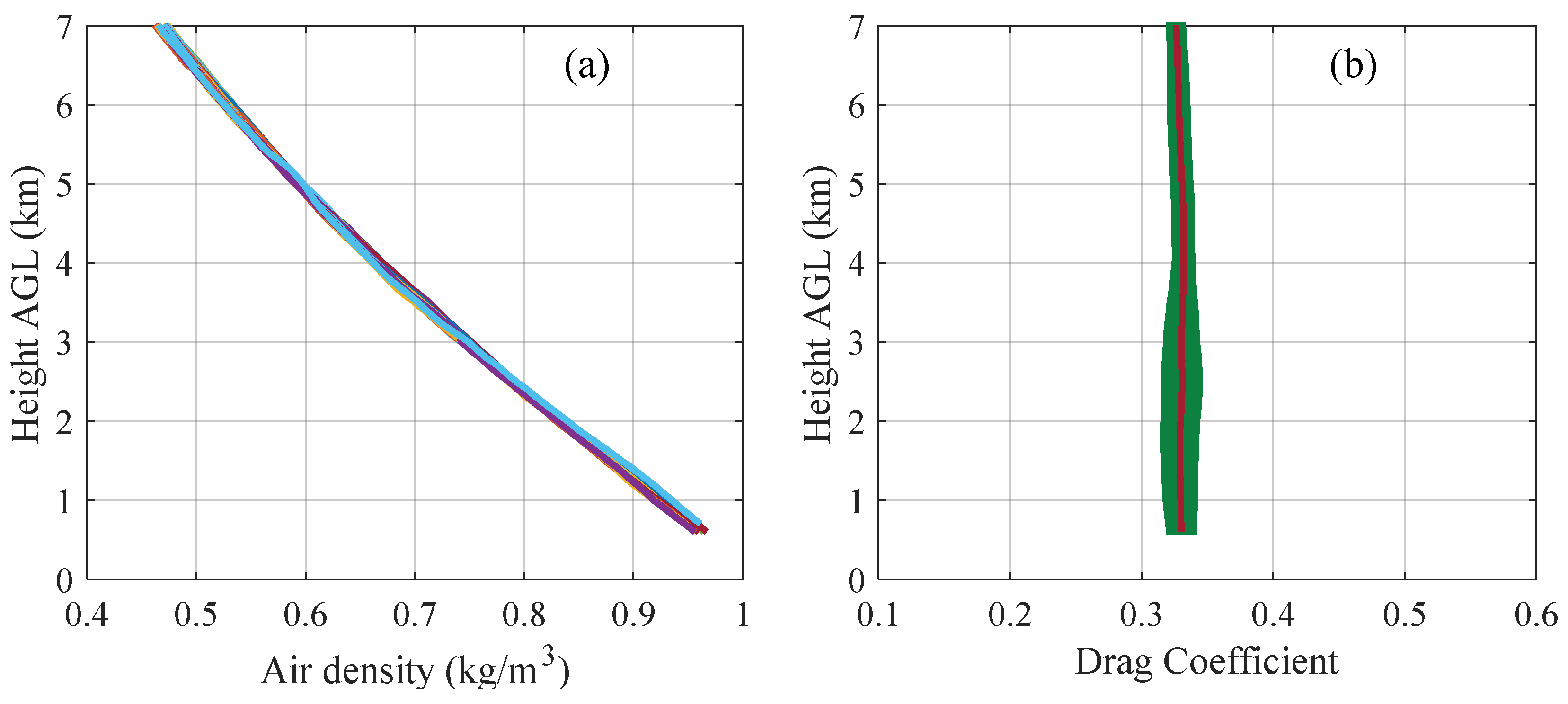

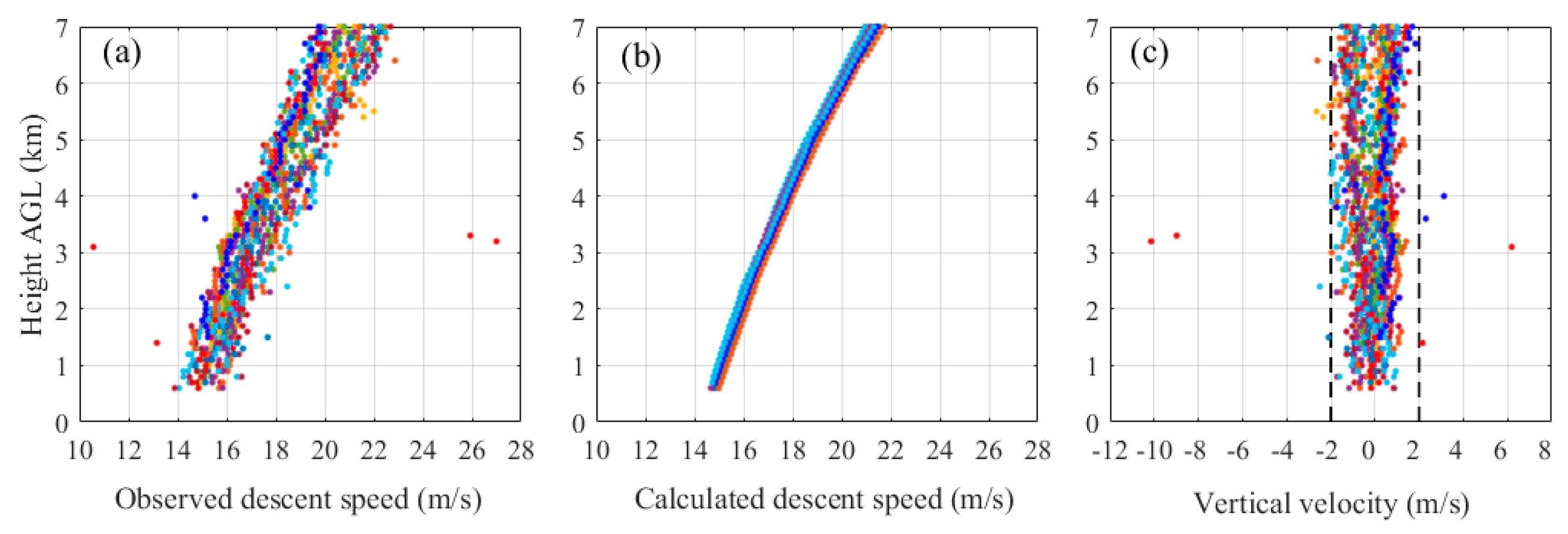
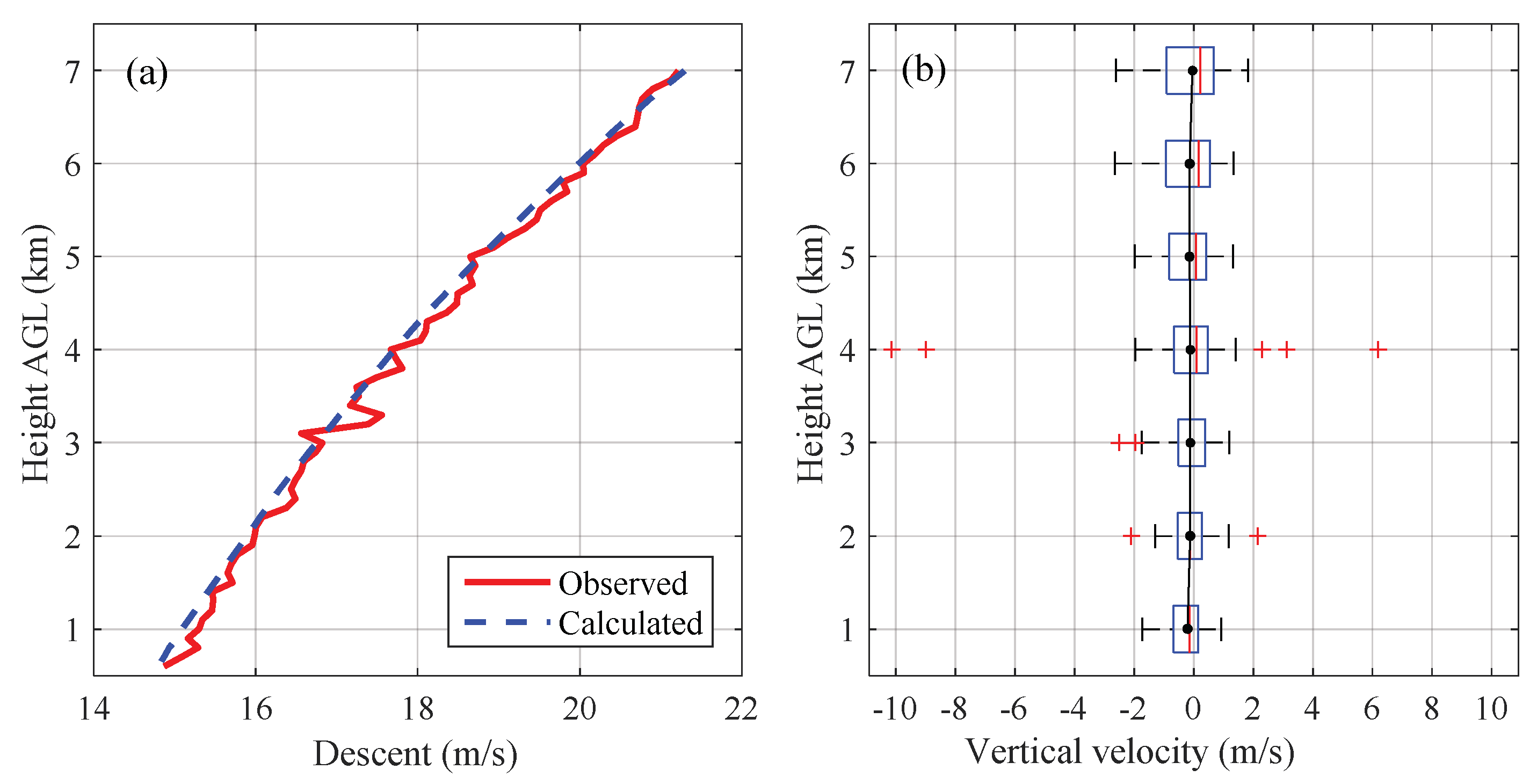
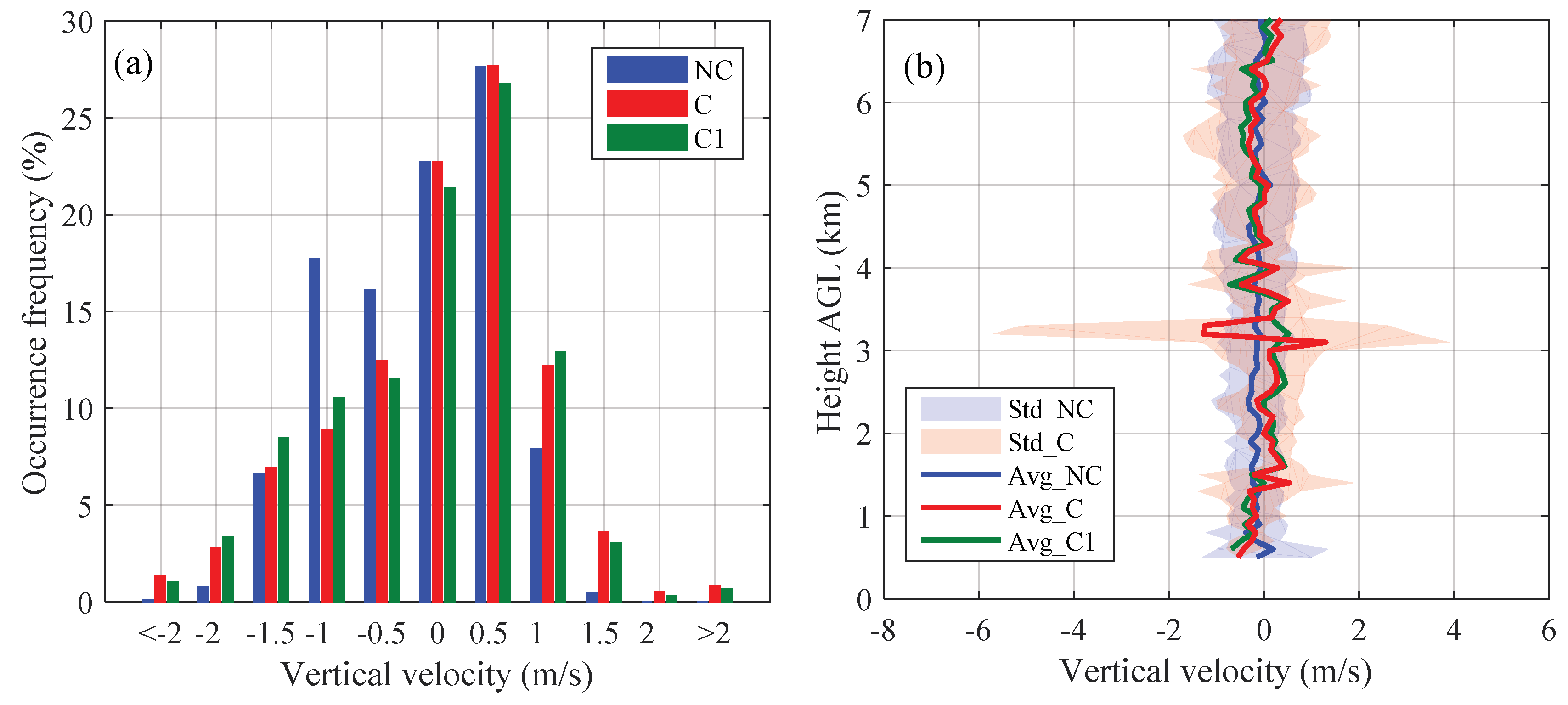
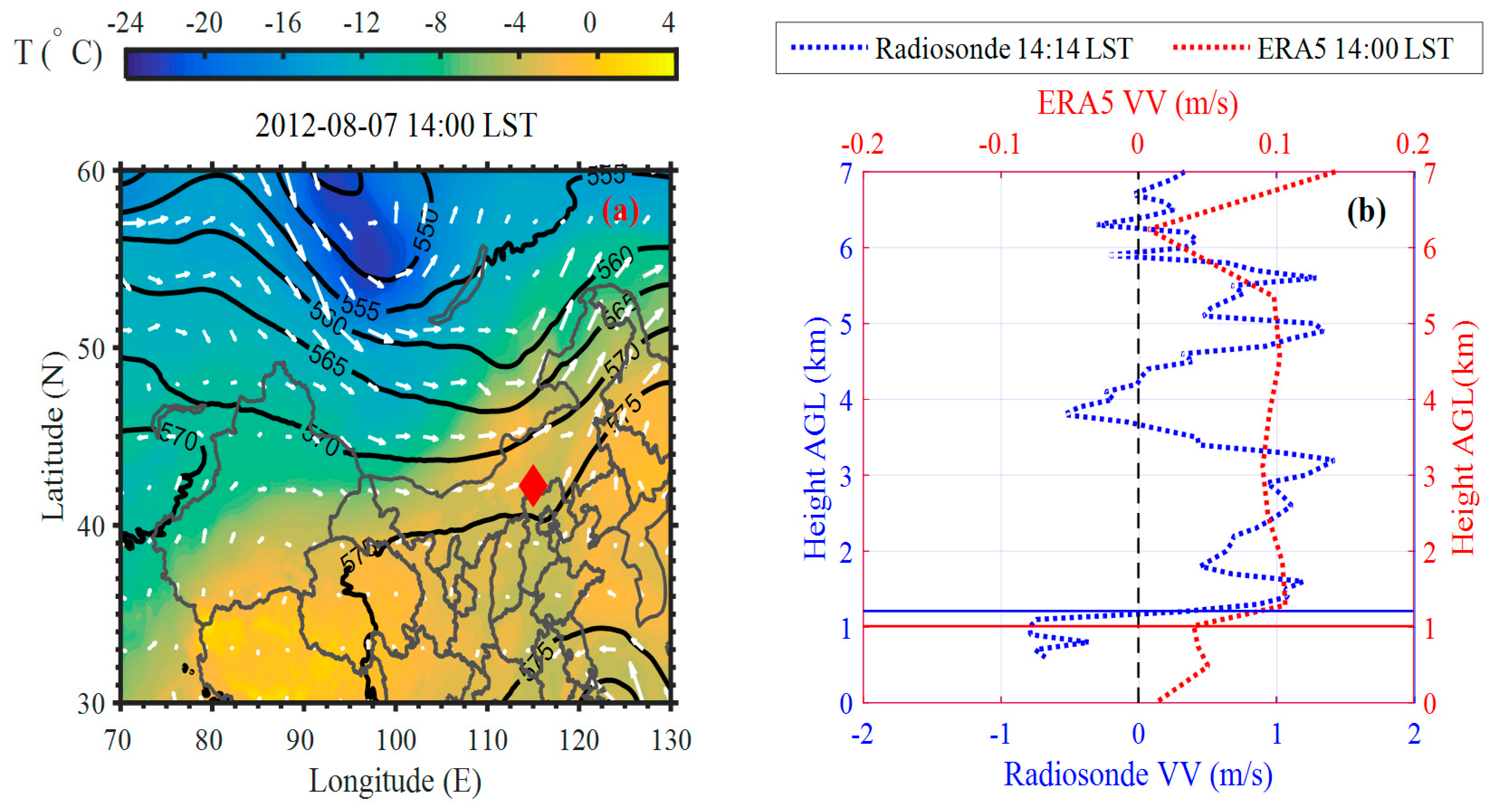
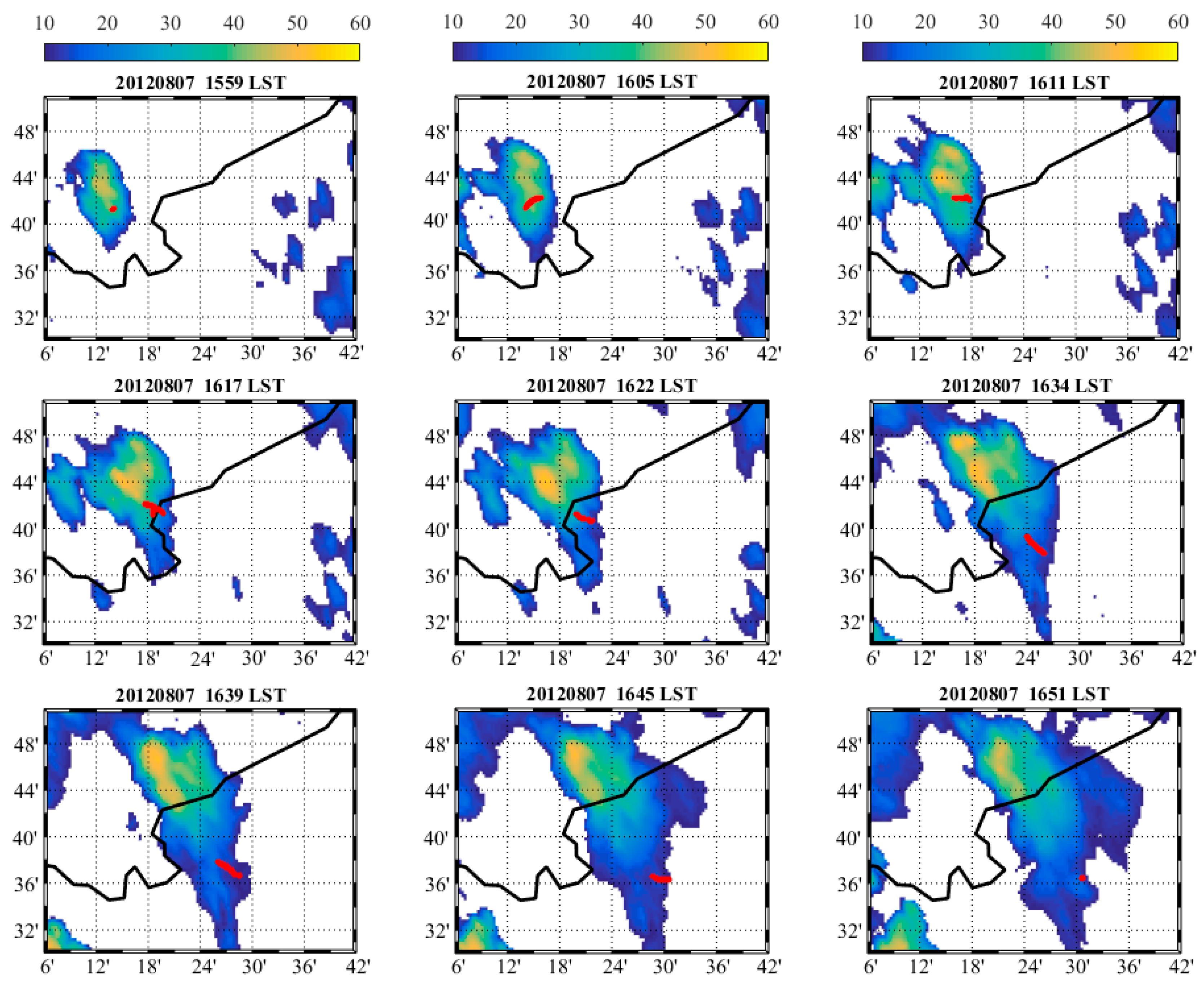
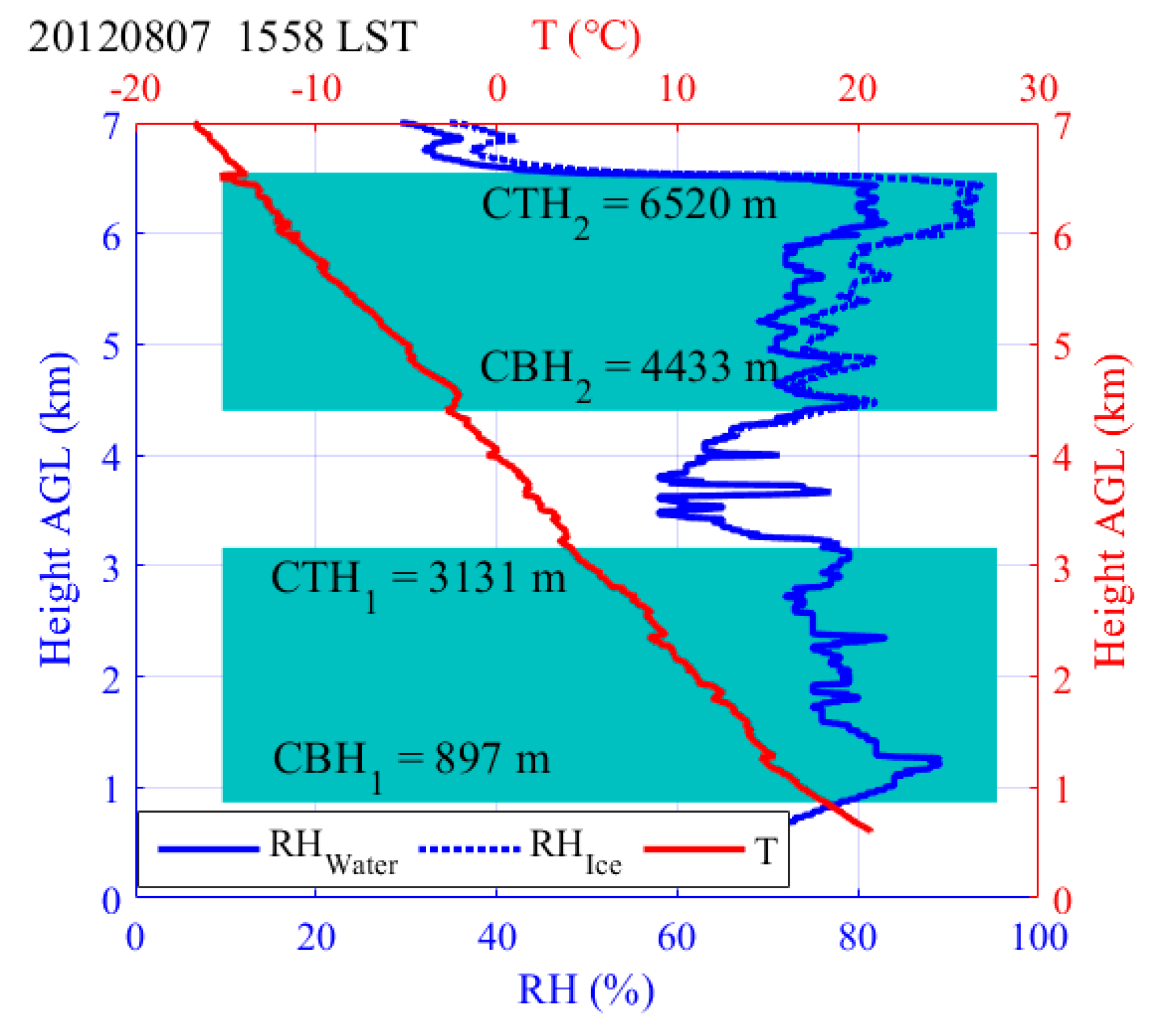
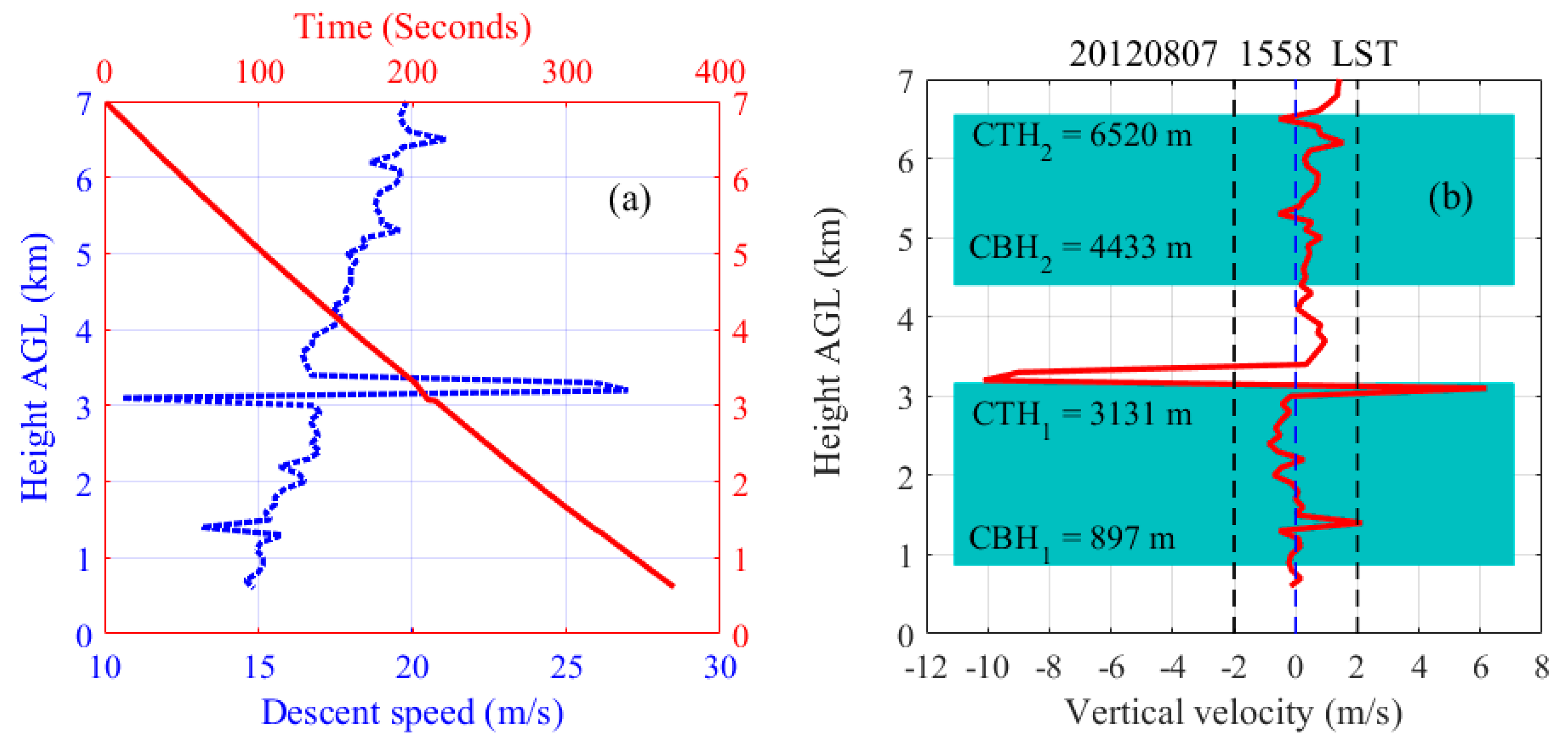
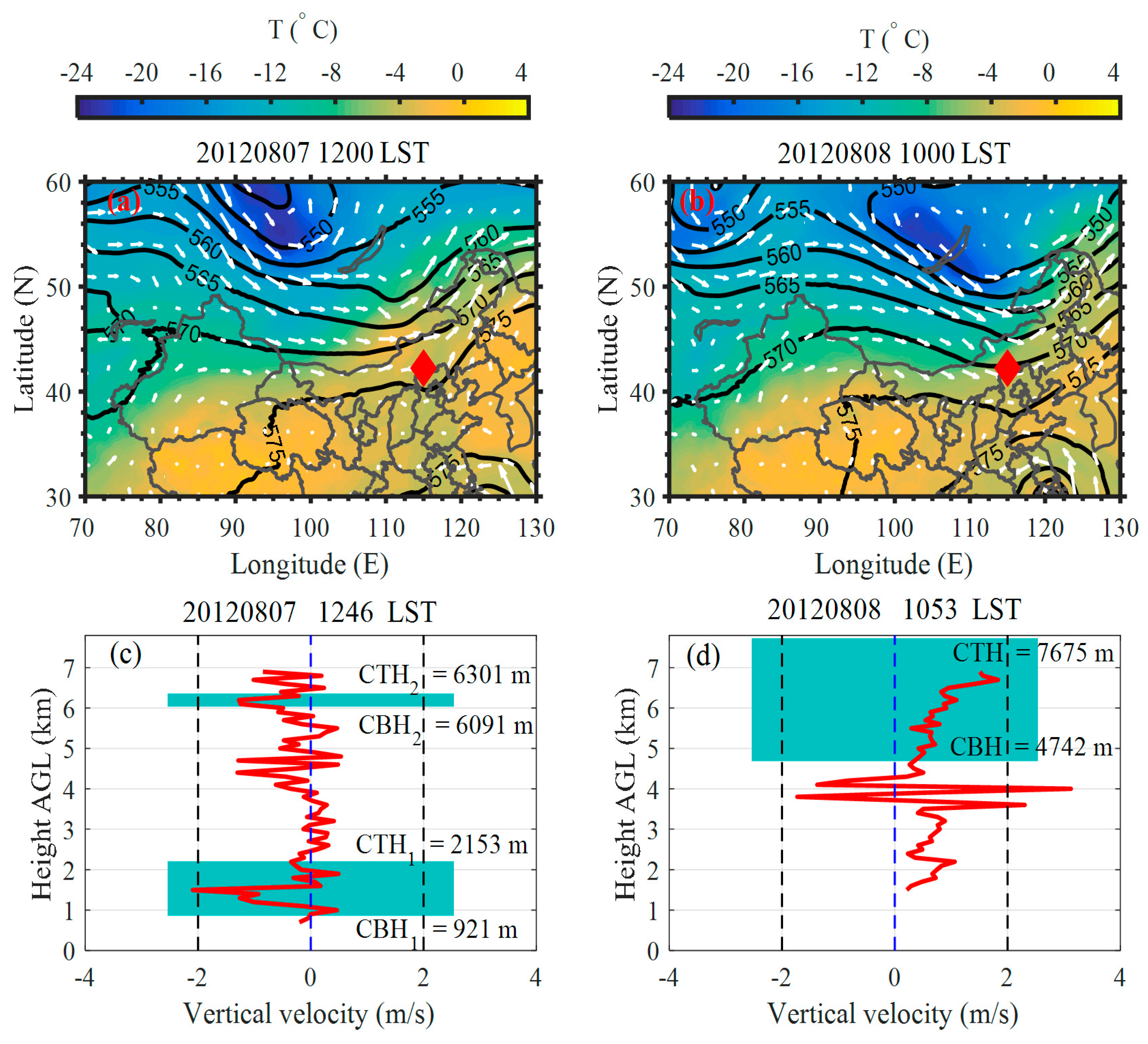
| Magnitude | Absolute Uncertainty | Relative Uncertainty | |
|---|---|---|---|
| 690 g | 1 g | 0.14% | |
| 1964 cm2 | 7.8618 cm2 | 0.40% | |
| 0.4684–0.9665 kg/m3 | 0.0016 kg/m3 | 0.17–0.34% | |
| 0.3261–0.3319 | 0.0037–0.0078 | 2.29–4.74% | |
| 14.68–21.29 m/s | 0.2393–0.3877 m/s | 1.18–2.38% |
© 2019 by the authors. Licensee MDPI, Basel, Switzerland. This article is an open access article distributed under the terms and conditions of the Creative Commons Attribution (CC BY) license (http://creativecommons.org/licenses/by/4.0/).
Share and Cite
Zhang, J.; Chen, H.; Zhu, Y.; Shi, H.; Zheng, Y.; Xia, X.; Teng, Y.; Wang, F.; Han, X.; Li, J.; et al. A Novel Method for Estimating the Vertical Velocity of Air with a Descending Radiosonde System. Remote Sens. 2019, 11, 1538. https://doi.org/10.3390/rs11131538
Zhang J, Chen H, Zhu Y, Shi H, Zheng Y, Xia X, Teng Y, Wang F, Han X, Li J, et al. A Novel Method for Estimating the Vertical Velocity of Air with a Descending Radiosonde System. Remote Sensing. 2019; 11(13):1538. https://doi.org/10.3390/rs11131538
Chicago/Turabian StyleZhang, Jinqiang, Hongbin Chen, Yanliang Zhu, Hongrong Shi, Youtong Zheng, Xiangao Xia, Yupeng Teng, Fei Wang, Xinlei Han, Jun Li, and et al. 2019. "A Novel Method for Estimating the Vertical Velocity of Air with a Descending Radiosonde System" Remote Sensing 11, no. 13: 1538. https://doi.org/10.3390/rs11131538
APA StyleZhang, J., Chen, H., Zhu, Y., Shi, H., Zheng, Y., Xia, X., Teng, Y., Wang, F., Han, X., Li, J., & Xuan, Y. (2019). A Novel Method for Estimating the Vertical Velocity of Air with a Descending Radiosonde System. Remote Sensing, 11(13), 1538. https://doi.org/10.3390/rs11131538







